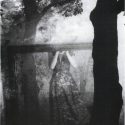Rut Gunhild Hillarp grew up in a Free Church community in Hässleholm and Lund. She was the daughter of a hardware dealer Nils Bengtsson from Hillarp and a former evangelist, Hulda Johansson, from Knäred. She married in 1932 and moved to Stockholm, where she studied literary history and languages and graduated in 1945. Her marriage broke up in 1947. Up to her retirement in 1980, Rut Hillarp was a teacher of Swedish, English, and drama and furthermore was active in the organisation Socialistiska Skolarbetare (socialist school workers) in the 1970s and edited the periodical KRUT – Kritisk Utbildningstidskrift (critical education periodical) in the 1980s.
She made her debut in 1946 with the poetry collection Solens bruun, a work of 1940s modernism, which like her subsequent two poetry collections Dina händers ekon, 1948, and Båge av väntan, 1950, are about the problematic relationship between the sexes in a patriarchal system. In four prose books, she delves deeper into the topic and keeps to a more or less lyrical style: Blodförmörkelse, 1951, Sindhia, 1954, En eld är havet, 1956, and Kustlinje, 1963. In 1950 she won a prize for her experimental film De vita händerna, and in 1982 she launched her poetry picture books with Spegel under jorden, followed by Penelopes väv, 1985, and Strand för Isolde, 1991. Her poems are based on mythical motifs, and the pictures, which have been exhibited in ten one-woman exhibitions, consist of photographic duplicates, often featuring faces in the landscapes.
Additions by the editorial team 2011:
The above biography was first published in 1998. Since then, excerpts of Rut Hillarp’s diaries have been published posthumously in 2011.


